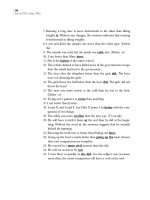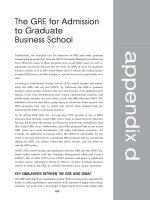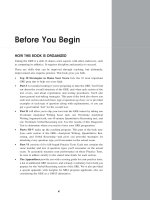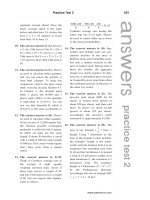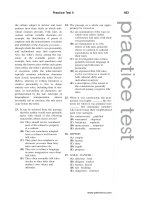Tài liệu Globalizing the Beauty Business before 1980 ppt
Bạn đang xem bản rút gọn của tài liệu. Xem và tải ngay bản đầy đủ của tài liệu tại đây (242.83 KB, 63 trang )
06-056
Copyright © 2006 Geoffrey Jones
Working papers are in draft form. This working paper is distributed for purposes of comment and
discussion only. It may not be reproduced without permission of the copyright holder. Copies of working
papers are available from the author.
Globalizing the Beauty
Business before 1980
Geoffrey Jones
Globalizing the Beauty Business before 1980
Geoffrey Jones
Joseph C. Wilson Professor of Business Administration
Harvard Business School
2
Globalizing the Beauty Business before 1980
This working paper examines the globalization of the beauty industry before 1980. This
industry, which had emerged in its modern form in the United States during the late
nineteenth century, grew quickly worldwide over the following century. Firms employed
marketing and marketing strategies to diffuse products and brands internationally despite
business, economic and cultural obstacles to globalization. The process was difficult and
complex. The globalization of toiletries proceeded faster than cosmetics, skin and hair
care. By 1980 there remained strong differences between consumer markets. Although
American influence was strong, it was already evident that globalization had not resulted
in the creation of a stereotyped American blond and blue-eyed beauty female ideal as the
world standard, although it had significantly narrowed the range of variation in beauty
and hygiene ideals.
3
Globalizing the Beauty Business before 1980
1
This working paper considers the globalization of the beauty industry between the
end of World War II and 1980. Like many consumer products, this industry has made the
transition since the late nineteenth century from one in which numerous small enterprises
sold products for their immediate localities to one in which “global brands” sold by a small
number of large corporations can be found worldwide. The beauty industry has a number of
distinctive characteristics which make it of unusual interest, however, including that it
appeared relatively late, that most of its products were marketed initially to women, that it
became characterized by large advertising budgets, that it spanned the health/science and
aesthetics/beauty arenas, that demand was shaped by deep-seated cultural and societal
norms, and that its products affect – in an intimate fashion – how individuals perceive
themselves and others. There is compelling research from a range of social sciences that
there is a “beauty premium.” Physical attractiveness, which may be enhanced by the
products of this industry, exercises a major impact on individual lifestyles, ranging from
the ability to attract sexual partners to lifetime career opportunities and earnings.
2
Historical studies of the beauty industry are confronted by definitional issues.
Broadly the industry includes products applied to the human body to keep it clean and
make it look attractive. It encompasses bath and shower products, such as toilet soap;
deodorants; dental, hair and skin care products; color cosmetics (including facial and eye
make-up, lip and nail products); fragrances; men’s grooming products, including shaving
creams; and baby care products. In recent years, “beauty” has been treated as a single
industry; there are listings of the largest firms and their market shares.
3
Historically, there
4
were major differences between product categories, which appeared at different
chronological periods, and differ widely in terms of production economics and distribution
channels. A distinction was often made between “toiletries,” such as toothpaste and
shampoo, and cosmetics and fragrances. At various times the industry was known as
“toilet preparations” or “personal care.” In many countries toilet soap was placed in a
different industrial classification.
4
The industry’s porous borders overlap with such services
as beauty salons and cosmetic surgery.
There is general agreement that a modern beauty industry emerged during the
second half of the nineteenth century. Rising discretionary incomes, urbanization and
changing values spurred fast growth, notably in the United States. Subsequently hygiene
practices and beauty ideals became widely diffused. The timing, extent and social and
cultural impact of this diffusion remains largely unexplored as the existing literature is
primarily nationally-based. The best historical studies on the industry are on the United
States.
5
This paper moves beyond national-based studies to examine the globalization of
beauty. As this paper will argue, although the process was underway in the nineteenth
century, it accelerated after 1945 despite apparent deep-seated obstacles to globalization.
As in all consumer products, there were wide cross-national differences in income levels,
distribution systems and regulations, but there were also strong physiological and cultural
influences on demand. While there is evidence that infants may share basic understandings
of “attractive” faces, regardless of ethnicity,
6
human beings have varied considerably in
how they presented themselves through clothes, hair styles and physical appearance. This
reflected skin tone and hair texture differences between ethnic groups, climatic and dietary
variations which impacted how people smelt and presented themselves, and cultural and
religious values.
5
This paper will consider the drivers of the globalization of beauty, the strategies
employed to firms to overcome challenges to globalization, and the outcomes, including
the extent to which globalization resulted in homogenization, or Americanization. As a
result, it seeks to contribute to understanding the relationships between corporate strategies,
consumption patterns and cultural and social norms in the globalization process. The
following section briefly reviews the emergence of a modern beauty industry, and its rapid
growth in the United States and elsewhere before the Second World War. Section 111
considers the drivers and obstacles to globalization. Sections IV and V will examine
corporate strategies and their impact, and explore why globalization proceeded much faster
in toiletries than hair care and, especially, color cosmetics.
II
The emergence of the modern beauty industry was driven by the new possibilities
arising from the potential of mass production and mass marketing, and from the application
of scientific research to industrial products. Rising incomes enabled growing numbers to
engage in discretionary spending. Rapid urbanization heightened concerns about hygiene
and the prevention of disease. Changing diets led to new health issues, including increasing
tooth decay.
7
Shifts in values were significant also. In Western societies, most people smelt badly
until the middle of the nineteenth century, due to a widespread aversion to washing with
water which became prevalent during the outbreaks of bubonic plague in the Middle Ages.
8
However thereafter personal cleanliness assumed the status of an indicator of moral, social
and racial superiority. Hygienic standards became a means to define social hierarchy and
6
difference, and an attribute of female domesticity. Regular personal washing became
routine in middle-class households in the United States at this time.
9
Following a revolution in soap-making technology in the early nineteenth century,
numerous soap manufacturers were established. In the United States these firms included
Colgate (1806), Procter & Gamble (P & G) (1837), B. J. Johnson (1898) – renamed
Palmolive in 1917 – and, in Britain, Yardley (1770), Pears (1789) and Lever Brothers
(1884). These companies initially made cakes of soap for washing clothes. There was a
sharp distinction between laundry soap, a minor branch of the tallow trade, whose chief
product was candles, and “toilet soap,” part of the perfumery industry centered on France.
10
From the mid-nineteenth century laundry soap companies entered the toilet soap business.
The soap industry grew rapidly as a result of the application of the new mass marketing and
production methods.
11
There was considerable product and marketing innovation, especially in the United
States. Colgate sold its first toothpaste in 1873, packaging its powders and pastes in a jar,
and in 1896 invented the collapsible toothpaste tube. Shaving creams were developed in
response to a rapid decline in the wearing of beards by men. Gillette, a metal fabricator,
invented the safety razor in 1901, and sold shaving creams.
12
Cosmetics made a transition
from a handicraft to a factory industry as the association between the use of cosmetics and
immoral behavior broke down in the United States.
13
Female entrepreneurs were
prominent, typically working outside established wholesale and retailing systems,
distributing products by mail order, through beauty salons, and door-to-door sales, and
sometimes pioneering wholly new marketing techniques.
14
The California Perfume
Company (renamed Avon in 1939) developed direct selling on a large scale, creating
markets in rural America.
15
Mass production and mass marketing techniques created new
markets. The pioneers included Chesebrough, initially a firm that sold kerosene, which
7
developed Vaseline petroleum jelly in 1878, and Pond’s Extract Company, which
introduced Pond’s Cold Cream and Vanishing Cream in 1907.
16
In Europe, product innovations frequently originated from pharmacists and
chemists. Beiersdorf, which originated as a pharmacy which pioneered medical plasters,
created Nivea cream, the first long-lasting moisturizer in 1911. In 1903 Hans Schwarzkopf,
a chemist and drugstore owner, developed a powder shampoo. Previously hair had been
washed using soap or with expensive oils. In France, L’Oréal originated with the invention
by a young chemist of the first safe synthetic hair-color formula in 1907, which was sold to
hairdressers.
17
France was the home of Haute Couture in beauty as well as fashion. Its role
as the global center for perfumery was enhanced during the nineteenth century by advances
in chemistry which permitted the creation of new scents, and by marketing innovations,
such as François Coty’s selling of perfume in smaller bottles.
18
During the interwar years that the beauty industry grew to a substantial scale in the
United States. Retail sales of cosmetics and toiletries were still only $45 million in 1915,
and $129 million in 1920.
19
By comparison, retail sales of fish in that country at the end of
World War I were $25 million, and fresh vegetables and fruits were $978 million.
20
In
1916 only one in five Americans used toilet preparations.
21
By 1930 retail sales of
cosmetics and toiletries in the United States had reached $340 million, and $840 million
twenty years later.
22
There was further product innovation. Baby powder, first developed
by Johnson & Johnson during the 1890s, became a mass market item in the United States,
while a range of specialist creams for babies were developed.
23
Existing products became
more affordable and accessible. The first metal lipstick container appeared in 1915; the first
screw-up lipstick was invented in 1921. American entrepreneurs developed mascara,
shampoos, and home-purchased hair dyes. The 1920s saw the emergence of three major
women’s fashion magazines – Vogue, the Queen, and Harper’s Bazaar – which
8
popularized styles and fashions, and in which beauty companies could advertise. With the
advent of radio broadcasting there was a decisive turn of cosmetics towards national
advertising and media-based marketing. Cosmetic products such as lipstick and nail polish
– developed commercially by Revlon in the 1930s – gained social acceptance. At the
outbreak of the Pacific War in 1941, the US government declared the production of lipstick
a wartime necessity.
24
By 1948 perhaps 90% of American women used lipstick, and two-
thirds used rouge.
25
Three distinctive types of firm were active participants in the industry. First, large
consumer products companies sold toilet soap, dental products, men’s shaving, and baby
products, categories which could be exploited by mass marketing and mass production. P &
G’s small personal care business remained largely toilet soap. The firm launched the iconic
Camay beauty bar in 1926. Colgate-Palmolive, created by merger in 1927, built a large
toothpaste business. Unilever, created in 1930 by the merger of Lever Brothers and
Margarine Union of the Netherlands, sold toilet soap, toothpaste, and perfumery as a small
part of its overall business, which was primarily laundry soap and edible fats.
26
Secondly, pharmaceutical companies, especially for Over The Counter (OTC)
markets, manufactured dental products, toothpaste and some cosmetics. In the United
States, Lehn & Fink sold toothpaste and owned the Dorothy Gray brand of cosmetics. Vick
Chemical, whose largest business was its famous vapor rub, acquired a man’s toiletries and
the Prince Matchabelli cosmetics businesses in 1941. Bristol-Myers sold its original
pharmaceutical business during the interwar years, and devoted itself entirely to its
specialties, including toothpaste – it launched the Ipana brand in 1916 – and toiletries,
before becoming a large penicillin manufacturer during the 1940s. British-based Beecham,
a long-established firm in patent medicine, diversified into OTC powders, pills and cough
mixtures and health drinks, and acquired a British toothpaste company, Macleans, in 1938,
9
followed by the manufacturer of a man’s hair preparation Brylcream, designed to keep
combed hair in place, which was among the first mass-marketed men’s hair care products.
27
In 1945 the Swiss pharmaceutical company Hoffman La Roche, which had a large vitamin
business, entered the personal care industry when the synthesis of the vitamin pathenol led
to the development of the hair lotion Pantene.
28
Finally, there were numerous specialty color cosmetics, skin and hair care firms,
some of which sold toilet soap and dental products. This category was populated by
numerous smaller, entrepreneurial firms, which typically began as specialists in single
products, including make-up (Max Factor), mascara (Maybelline) or shampoos (Helene
Curtis). There were an estimated 750 firms in the American cosmetics industry alone in
1954.
29
There were smaller numbers of firms in Europe, and occasionally elsewhere,
including, Shiseido, founded as a Western-style pharmacy in Japan in 1872.
The emergence of a modern beauty industry coincided with the rapid globalization
of the world economy during the second half of the nineteenth century.
30
Given the
importance of values in the growth of this industry, it is not surprising that it assumed a
quasi-ideological role. There was a rapid globalization of certain hygienic practices. The
export of soap came to be regarded as an important contributor to the mission of
“civilizing” colonized peoples.
31
In colonial southern Africa, the alleged lack of hygienic
habits by indigenous Africans formed an important component of colonial racist rhetoric.
32
As Meiji Japan sought to modernize in the late nineteenth century, the government
explicitly changed the hygienic and cosmetic practices, discouraging tooth blackening, as
well as whitening of male faces.
33
Toilet soap led the globalization process. During the nineteenth century Pears built
a large market for its soap in the United States.
34
By the 1930s a number of brands were
widely sold. Colgate-Palmolive had factories in Canada, Latin America, Europe and
10
Australia, mainly making laundry soap, but also Palmolive toilet soap. This was the leading
toilet soap on the British market, even though it was imported from Canada before local
manufacture began in 1939. A number of toothpaste and shaving cream brands were also
sold internationally. Johnson & Johnson and Gillette manufactured and sold in several
countries, as did Unilever.
35
In skin and hair care, color cosmetics, and fragrances, a number of firms sold on a
smaller scale to other developed markets. As Max Factor flourished providing make-up for
Hollywood stars, the firm began to export during the early 1920s, and established a factory
in Britain in 1935. Elizabeth Arden and Helena Rubenstein developed substantial sales in
interwar Western Europe. The latter was able to retain a large business in Nazi Germany
despite nationalistic and sometimes anti-cosmetic rhetoric.
36
American entrepreneurs
scanned foreign countries for new ideas. The founder of Clairol acquired a new formula for
hair coloring while visiting France in 1931.
37
Pond’s developed a large international
business. It opened its first foreign plant – in Canada – in 1927. Two decades later Pond’s
sold in 119 countries, and international revenues represented more than 40% of the total,
and 65% of total profit. Chesebrough’s Vaseline’s Hair Tonic was also sold in numerous
countries by the 1940s.
38
European companies often marketed abroad early in their corporate lives. French
fragrances were sold in many countries during the nineteenth century. They dominated the
interwar American market, both for prestige products and cheaper brands sold at drug
stores.
39
By 1914 L'Oréal’s products were already sold in the Netherlands, Austria and
Italy, while two-fifths of Beiersdorf’s products were sold outside Germany.
40
European
companies opened factories in the United States to avoid tariffs. British-owned Yardley
opened a New Jersey factory in 1928, while Coty, the French fragrance firm, formed a US-
based company which within a few years acquired the related Coty companies in Europe.
41
11
Gal, a Spanish perfume and soap company, developed a large export business to Latin
America before the outbreak of the Spanish Civil War in 1936.
42
III
The United States emerged from World War II as by far the largest single beauty
market. Table 1 provides the first published estimate of the size of the global market in that
year and subsequent benchmark years. It excludes the Communist world. North America
accounted for two-thirds of color cosmetics consumption in 1950, even higher than its
share of total personal care market.
43
The overall importance of the American market was
reflected in the dominant position of US firms in the world industry (see Appendix Table
1).
12
Table 1 World Beauty Market in 1950, 1959, 1966 and 1976 ($ million and $ 1976
million)
1
1950 1959 1966 1976
North America
589 1,270 2,455 6,000(e)
USA 560 1,184 2,430 5,670
Europe
287 543 1,600 4,740
France 62 105 430 972
Germany 62 132 350 1,586
Great Britain 58 124 290 581
Italy 57 84 240 553
Scandinavia 14 21 58
Australia and New Zealand
15 32 66 214
Asia (excluding Japan)
30 82
India 16 37 74
Indonesia 6 10 90
Japan
24 112 285 1,957
South America
61 80
Brazil 28 38 372
Argentina 18 24
Africa
12 18
South Africa 7 11 141
Nigeria 8 49
“World”($nominal) 1,026 2,173 5,200 15,000(e)
“ World”(constant $1976) 2,422 4,248 9,131 15,000(e)
1
Data is for manufacturers’ shipments, not retail sales, and exclude toilet soap. Communist
countries are not included. Pounds and Yen converted to US dollars at current exchange
rate.
Sources: The main sources for 1950 and 1959 are Preparations and Perfumery Survey,
1950-51, June 1951, Report 3508; and World Toilet Preparations Survey 1959-1960,
Report 3110, UAR. Unilever estimates exclude Japan, and Communist countries. The
Japanese data is derived from Japanese Cosmetics Industry Association, Japanese
Cosmetics Industry – 120 Years of History (Tokyo, 1995). For 1966, Euromonitor (1967),
Table 101, p. 105; the US figure is from Industrial Outlook. For 1976, the US data is
derived from Industrial Outlook, the Japanese data from Japanese Cosmetics Industries,
and the remainder from Toilet Preparations Coordination Forward Plan 1977-1981, UAL,
and OSC Product Strategy, 1974-1979 Discussion Paper (May 1976), ES76064, UAR
13
The pre-eminence of the United States in 1950 was exaggerated by the depressed
disposable incomes in postwar Europe, Japan and elsewhere, yet there was little doubt that
the American market was uniquely important because of its size, level of discretionary
incomes, and value systems, which had turned beauty products into a “necessity” rather
than a “luxury.”
The American market was also perceived as homogeneous. The “ethnic” cosmetics
market, which overwhelmingly sold products specially formulated and marketed to
African-Americans, was 2.3 per cent of the total US market in 1977.
44
The dominant
discourse of ideal female beauty in interwar and postwar America was Caucasian. Non-
whites were prohibited from participation in Miss America beauty contests for three
decades after their inception in 1921. There were a handful of ethnically diverse contestants
in the late 1940s, and the first and (so far) only Jewish winner was in 1945. However, it
was only in the late 1960s that African Americans could enter the national contest and the
first to win was in 1984. Since 1921, over one-third of contestants have been blond.
45
Barbie toy dolls, created in the late 1950s, were blue-eyed and (predominately) blond until
1980, although the early prototypes, designed in Japan, had distinctly East Asian eyes.
46
These beauty ideals were well-represented in Hollywood movies, such as the Marilyn
Monroe classic Gentlemen Prefer Blondes (1953), which became powerful drivers of
fashion standards. The burgeoning cosmetics industry and from the interwar years
cosmetics companies used Hollywood starlets to advertise their products.
47
The large American market stimulated continual marketing and product innovation.
Cosmetic companies expanded demand by television advertising and sponsored game
shows.
48
However, the market remained heavily skewed towards women, despite quite
strong attempts to expand the male market. A survey on male products in 1962 concluded
with “the blunt fact that the market has been nearly static for 50 years.”
49
Although
14
branding and marketing was the basis of competitive success in the industry, product and
process innovation was important in expanding demand. This ranged from the basic
research which enabled advances in therapeutic toothpaste, anti-dandruff shampoos and
hair coloring, to constant experimentation in product formulations in creams and cosmetics
and testing of their effects on animals. Postwar product innovations included aerosols for
hair and fragrance products.
50
The size of the American market made evident its potential elsewhere. In 1950
Unilever asked senior executives to investigate the global prospects of the industry. The
subsequent investigation, which included a pioneering effort to quantify its size, identified
“a direct relationship between the standard of living and the usage of toilet preparations.”
The potential for global growth appeared even greater because the technology appeared
basic, fixed capital requirements were limited, and the industry was highly fragmented. The
industry was, the executives concluded, a “Unilever business.”
51
The following decades demonstrated the correlation between market growth and
increases in discretionary incomes. As incomes rose, consumers moved along a spectrum
of product categories spanning toilet soap, toothpaste, shampoo, mass cosmetics and
ultimately prestige cosmetics. In developing countries, Western products either created a
new market, as when shampoos replaced soap for hair washing, or substituted for
traditional, often handicraft, cosmetics. Like many branded consumer products from
automobiles to clothes, there was a strong aspirational driver behind this market growth.
However although cosmetics were famously described as providing “hope in a jar,”
experimental research suggests that they can enhance attractiveness.
52
Given the size of the
“beauty premium,” there was a strong rationality behind their purchase. An industry
estimate in the mid-1960s was that – worldwide – consumer purchases of personal care
items tended to increase about 112% for every 100% increase in income.
53
Table 2, which
15
compares the growth rates of the US and Japanese personal care markets and per capita
income between 1950 and 1976, shows that to have been a conservative estimate.
Table 2 Compound Annual Growth Rates of the US and Japanese Personal Care
Markets and GDP Per Capita 1950-1976
U.S Japan
Personal Care GDP
Per Capita
Personal Care GDP
Per Capita
Current
9.3 5.8 17.5 13.4
Constant
5.8 2.4 10.7 6.9
Sources: Japanese Cosmetics Industry Association, Japanese Cosmetics Industry – 120
Years of History (Tokyo, 1995); Industrial Outlook. Constant growth rate based
1976$ and 1976 Yen.
The international growth prospects of the industry were enhanced by globalization
of American cinema. During the interwar years the rise of Hollywood to dominate the
emergent world cinema industry intensified the diffusion of American hygiene and beauty
ideals both to other Western countries, and to developing countries with much lower
income levels and different cultural traditions. For example, there was a strong impact of
Hollywood movies, and their media coverage, on Iranian fashion and cosmetics culture
during the 1930s and 1940s.
54
The war years intensified this impact through explicit linking
of cosmetics sales with American lifestyle and democratic ideals, and interaction between
American servicemen abroad and local women.
55
The postwar growth in international
travel further diffused brands and products.
56
There were further drivers of global growth. There were economies of scale with
mass market products such as toilet soap and toothpaste. In prestige products, there was the
lure of high margins. The margins obtainable from selling cosmetics were reported to be
around 20% in the American industry during the 1960s and 1970s.
57
Beauty brands, with
their emotional and aspirational characteristics, seemed less vulnerable to commodification.
16
As new markets opened up, firms had strong incentives to capture first mover advantages
for their brands.
Yet there were at least three major obstacles faced by firms as they sought to build
global beauty businesses. The first related to markets. The problem was not merely that
most of the world after the Second World War lacked the level of disposable income to
purchase most of these products, but also that consumer preferences varied widely across
the full spectrum of beauty products even at similar income levels. For example, while the
per capita consumption of toothpaste was broadly similar in the United States, Switzerland
and Venezuela during the 1970s, it was nearly double that seen in France, Italy and
Brazil.
58
Fig 1, derived from Unilever data, illustrates the same phenomenon in shampoo
usage. While the ability to construct such comparative data demonstrated the informational
advantage held by firms with multi-country operations, it also demonstrates the complexity
in predicting changes in consumer expenditure.
17
0
100
200
300
400
500
600
700
800
0 1000 2000 3000 4000 5000 6000 7000 8000 9000
Ä India
Ä Turkey
Ä
Ä South Africa
Ä Malaysia
Ä Brazil
Thailand
Ä
Ä Venezuela
Ä Argentina
Ä Spain
Ä Greece
Ä Chile
Ä Italy
Ä UK
Ä Japan
ÄGermany
ÄU.S.A.
Ä Sweden
Ä Switzerland
France Ä
Fig. 1 Consumption of Shampoo Relative to GDP
per capita, c1982
Percaput. M1/Head
GNP/per capita (
£Sterling)
Indonesia
Source: UAR, ES 83111 Economics Department, Shampoo Overseas (March
1983).
In skin care and cosmetics there were also wide differences in consumer
preferences. Japanese women hardly used fragrances, but had a strong preference for clear
skin. During the 1960s 60% of total personal care consumption in Japan was spent on skin
preparations. A preference for pale skin also made skin whiteners a major product. In 1980
the Japanese market for face creams was double the size of that of the United States.
American women, in contrast, were highly “made-up.” By the early 1960s an estimated
86% of American girls aged 14 to 17 already used lipstick, 36% used mascara, and 28%
used face powder.
59
18
The beauty markets of neighboring European countries differed widely. Table 3
shows the major variations in propensity to use skin creams, lipsticks and deodorants in the
early 1960s.
Table 3: Female Use of Skin Preparations in Europe, 1963 (%)
Hand and Face Cream Lipsticks Deodorants
France 54 58 25
Germany 75 38 29
Belgium 32 51 14
Italy 20 25 12
Britain 60 73 48
Source: UAR, TR 67002, E and S, Markets for Skin Preparations, An Interim Report. 12
December 1967.
Although consistent time series data is elusive, the differences seemed as strong two
decades later. In the early 1980s Germans remained high spenders on skin creams. The
French remained low users of deodorants (and soap) compared to the British and Germans,
but far greater consumers of fragrances. Over a quarter of the entire French beauty market
was fragrances compared to 8 per cent in Germany, while French per capita consumption
was twice that of Britain and Germany.
60
Consumer purchasing behavior in the same
category also varied widely between countries. French female fragrance consumers had a
strong preference for prestige products and were loyal to one or two scents. In the United
States, there was a far higher consumption of mass market fragrance brands, and typically
consumers used more fragrances.
61
There were multiple factors driving cross-national differences in consumption
patterns. These included persistent variations in grooming habits. In the 1970s two-thirds of
19
French, German and Swedish women showered, but 90% of British women preferred to
wash in the bath tub. Americans also overwhelmingly preferred showers.
62
There continued
to be wide variations in social attitudes towards cosmetic use. “In Germany,” a report
conducted by Unilever in 1963 observed, “the puritanic view of a strong connection
between beauty care and condemnable sex enhancing methods is still widespread and
hampers the growth of the color range products.”
63
A second set of obstacles to globalization related to access to distribution channels
and marketing. The advertising strategies used to grow the US beauty market were not
readily transferable. There were many restrictions on media advertising outside America.
The United States had six commercial television stations by 1945, and a decade later over
400, but commercial television was only launched in Japan in 1953 and Britain in 1955,
and was even later elsewhere in Europe and other countries. There were often restrictions
on product advertising, and few countries permitted sponsored game shows.
64
Finally, there were obstacles to globalization arising from differences both in
human physiology and governmental regulations. Products and brands needed some
reformulation because of differences in skin tone, hair texture, diet and climate. Moreover
as the products of the industry could affect health, there was quite extensive regulation of
permitted formulations and preservatives, claim substantiations and ingredient labeling.
These varied widely between the United States, Europe and Japan.
65
IV
The task of globalizing beauty products after 1945 appeared to provide fewer
challenges for the large consumer products companies which had established international
businesses in laundry soap and other consumer products. They had the resources and
20
sometimes the local geographical knowledge to grow businesses in personal care. They had
the large advertising budgets and marketing skills needed to create attractive international
brands. There were also economies of scale in the manufacture of such products, enabling
the creation of entry barriers. As most developing countries had high tariff barriers during
the postwar decades, multinational firms which created factories behind them could capture
strong market positions with limited competition.
The consumer products companies undertook a rapid globalization of toilet soap,
toothpaste and shaving creams. They both exported and built foreign factories. By the
1970s Unilever, Gillette, and Colgate-Palmolive manufactured in numerous developed and
developing markets. The latter firm had over 30 factories outside the United States spread
over Europe, Latin America, Africa and Asia, by the early 1970s.
66
Global brands were
developed in these product categories, although firms typically struggled to achieve
uniformity in composition or packaging in different countries. Palmolive was sold in
numerous countries. Unilever’s Lux toilet soap, created in the 1920s, was sold on five
continents by 1960.
67
As firms considered entering in developing countries, firms such as
the US advertising agency J. Walter Thompson were employed to collect basic information
about market size and consumer preferences.
68
There was also product and marketing
adaptation to the conditions in those countries. In Thailand, where Unilever held nearly 50
per cent of the total toilet soap market with Lux in the early 1980s, the local company
formulated its toilet soap with no tallow, using locally produced palm oil. In India,
Unilever both used local ingredients and introduced special low cost brands during the
1970s in response to government requests.
69
The market for toothpaste grew rapidly after 1945, including in developing
countries where its use had been minimal previously. As in toilet soap, a global oligopoly
emerged. Toothpaste replaced toilet soap as the driver of Colgate-Palmolive’s international
21
growth. Unilever also pursued a global strategy with Pepsodent, an American brand which
it had acquired in 1944. By 1959, as Table 4 shows, a small group of firms held significant
shares of many national markets, even though powerful local incumbents were present in
some of them, such as Germany, where Blendax held one-third of the dental market.
Table 4: Market Shares in Selected Dental Markets, c1959 (%)
Country
Total
Market Size
($ million)
Colgate-
Palmolive
Unilever
P&G
Bristol-
Myers
Beecham
United States 167 30 19 20 n.a. n.a.
UK/Ireland 23 27 32 9 n.a. 19
Germany 19 16 14 n.a. n.a. n.a.
France 8 40 31 n.a. n.a. n.a.
Denmark 2 42 13 n.a. n.a. 20
Brazil 9 21 9 n.a. n.a. n.a.
Thailand 2 82 n.a. n.a. 9 n.a.
India 11 17 2 n.a. n.a. n.a.
Philippines 4 96 n.a. 4 n.a. n.a.
Australia 6 56 12 n.a. 17 n.a.
South Africa 3 51 18 n.a. 11 n.a.
Source: UAR, Report 3110, World Toilet Preparations Survey 1959-1960.
By the 1970s Colgate-Palmolive sold around one-third of world toothpaste outside
Japan and the Communist countries, while Unilever and P & G a further one-fifth each.
This was a product category in which first-mover advantages, including in brand
reputations, were strong, although not invincible. Colgate-Palmolive’s dominance in the
United States was overwhelmed by P & G’s blockbuster Crest, launched in 1955, which
eventually took and held two-fifths of the market. Beecham also briefly captured 8% of the
American market during the 1960s, initially by encouraging sampling of Macleans
toothpaste by giving a tube away free with the well-established Brylcream hair dressing
product.
70
22
Both men’s shaving products and the new category of deodorants were rapidly
globalized during the postwar decades. In 1950 Gillette held over a quarter of the total
world market for the former product. This firm expanded rapidly in postwar Latin America
and was strongly represented in Europe, where it competed with Unilever and Colgate-
Palmolive. During the 1970s Gillette held around a one-fifth of the French, German and
British shaving markets.
71
Bristol-Myers, Gillette and Unilever globalized deodorants as a
replacement for soap and colognes. Bristol-Myer’s Mum, an underarm deodorant based on
the same principle as the newly invented “ball point” pen, was rapidly internationalized
after its launch in 1952. Gillette’s Right Guard aerosol deodorant, launched in 1960, and
Unilever’s underarm deodorant brand Rexona competed in dozens of markets. By 1979
Rexona held 7% of the “world” deodorant market outside Japan and the Communist
countries.
72
The surprising omission from the above list, which emphasized the limits to
globalization, was P and G. During the 1950s this firm, which was twice the size of
Colgate-Palmolive, remained heavily focused both on the North American market, and
laundry soap and synthetic detergents, where it had secured a world-wide technological
lead. There were limited international sales of shampoo in Canada and other developed
countries, and of Camay in Latin America and the Philippines, but this never developed as
global brand. From the 1950s P & G expanded its international business, previously
focused on Canada and Britain, into Continental Europe, and to a limited extent elsewhere.
However international expansion was driven by detergents and, from the 1960s, Pampers
diapers, which were both highly capital-intensive businesses. While Pampers was sold in
more than 70 countries by 1980, Crest toothpaste and Head and Shoulders, the anti-
dandruff shampoo launched in 1961 which captured one-quarter of the American market,
were sold in half a dozen countries outside the United States.
73
23
The globalization of hair and skin care, and color cosmetics, proved challenging. In
these categories, competitive advantage rested less on scale economies and more in brand
image. Hair care proved a volatile business. As the product was quite inexpensive to
manufacture, there were low entry barriers permitting many new entrants. Consumers were
prone to experiment with different brands. The market shifted frequently with changing
fashions, and it was subject to technology shifts, such as the use of blow dryers during the
1970s.
74
Outside the United States, shampoo consumption was not widespread after World
War II, and initially almost entirely confined to women. Helene Curtis, a strong US
innovator, took the lead in the postwar globalization of hair products. By the 1970s Helene
Curtis brands could be bought in over 100 countries. However the firm’s use of agency
agreements to gain rapid access to markets seems to have limited its growth potential. By
that decade three-quarters of its revenues were earned in the United States,
75
and the large
consumer products companies and L’Oréal had become the largest international firms in
the category (Table 5).



